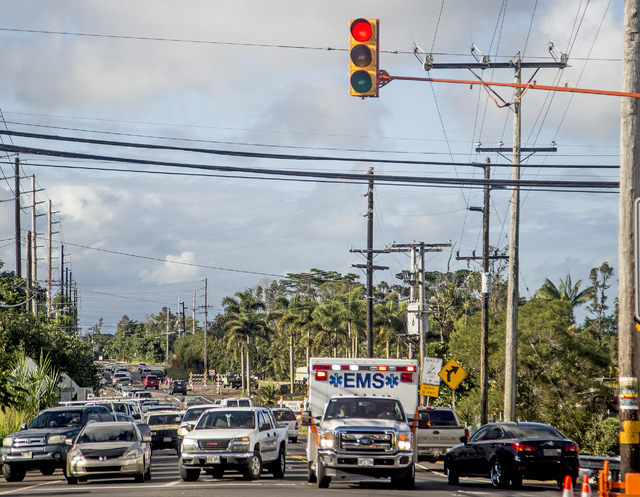Hawaii Island representatives are hoping the third try is the charm for a bill that would bolster ambulance services in Puna. ADVERTISING Hawaii Island representatives are hoping the third try is the charm for a bill that would bolster ambulance
Hawaii Island representatives are hoping the third try is the charm for a bill that would bolster ambulance services in Puna.
A version of the bill appears in both chambers of the state Legislature this session, and calls for an appropriation to add an advanced life support ambulance to the district. The appropriation also would fund the ambulance’s staff of a full-time paramedic and emergency medical technician.
“We did the ambulance bill because we don’t have an ER in Puna,” said House bill co-introducer Rep. Joy San Buenaventura (D- Puna). Sen. Russell Ruderman (D- Puna) introduced the Senate version.
Lance Uchida, battalion chief for the Hawaii Fire Department, which oversees emergency medical services on the island, said Tuesday that this is the third straight year his department has worked with legislators to craft the bill.
“Last year, we were very hopeful that the bill would be supported and enacted into law,” he said.
Puna is the fastest-growing district in the state and has seen a population increase of 44 percent since 2000. The population is expected to reach 75,000 during the next 15 years.
“Infrastructure isn’t keeping pace with population growth, and that includes medical infrastructure,” said Rene Siracusa, president of the board of directors for the Puna Community Medical Clinic in Pahoa.
There are currently 15 ambulance units on Hawaii Island. The last was added in 2005 and serves the Ocean View area.
Puna is serviced mainly by units in Pahoa and Keaau. There also is a unit based in Volcano. Last year, the district made up 30 percent of all EMS calls countywide.
“It’s busy out there,” Uchida said. “With the ambulance turnaround times, one call … could easily be a roundtrip of two hours. That happens on a daily basis.”
Problems arise when multiple calls come in during the same time frame. If the Keaau unit is free, it will handle the second call. If not, help comes from Hilo. And if Hilo is busy, the county uses a private ambulance contractor.
According to testimony from Fire Department Chief Darren Rosario at last year’s hearings, from 2011 to 2014, calls to the backup provider cost about $15,000 per month in charges.
“Pahoa is constantly pulling resources out from Hilo-based (units),” Uchida said. “There’s a collateral or trickle-down effect.”
Delays in ambulance arrivals can have serious consequences.
“That misses what they call the ‘golden hour,’” Siracusa said. “There’s only so much the EMTs can do to stabilize a patient; that ‘golden hour’ is critical. Very often, we don’t have it.”
During last year’s session, opposing testimony before the House Committee on Health centered on financial concerns. The Department of Health, which handles the EMS Special Fund, stated that it was “projecting a shortfall … to fund the existing ambulance contracts across the state for FY16 and FY17.”
“It all depends on (funding), but I think we have a good shot if we keep reminding the Finance Committee that it’s important,” San Buenaventura said.
Email Ivy Ashe at iashe@hawaiitribune-herald.com.



